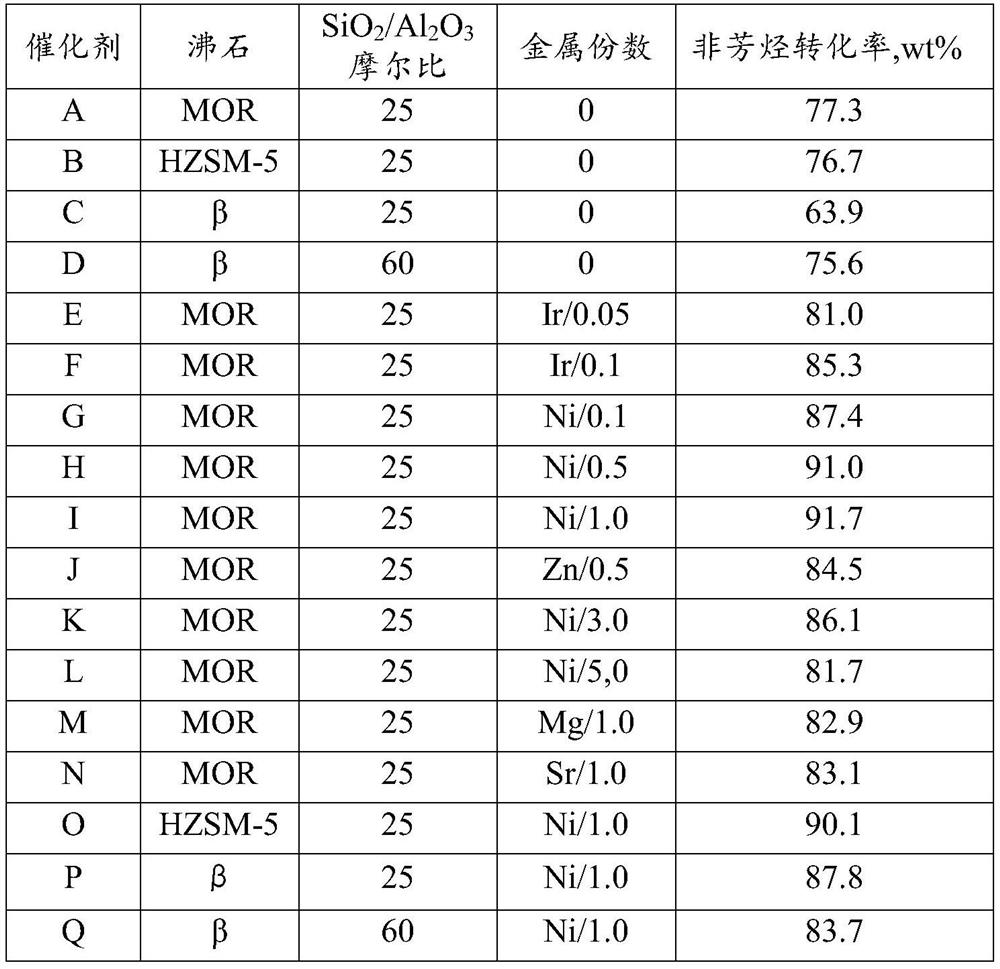Method for selective cracking of non-aromatic hydrocarbons
A non-aromatic, selective technology, applied in the field of selective cracking of non-aromatics, can solve the problems of poor selectivity and low cracking catalyst activity, achieve the effect of reducing strong acid sites and improving cracking activity
- Summary
- Abstract
- Description
- Claims
- Application Information
AI Technical Summary
Problems solved by technology
Method used
Image
Examples
Embodiment 1
[0033] SiO 2 / Al 2 O 3 195g of 25 mordenite and γ-Al 2 O 3 107.1g is uniformly mixed, then dilute nitric acid and sesbania powder are added and kneaded uniformly, extruded into strips, roasted to form a carrier, cut into pellets, and placed in a dipping container. The metal precursor iridium chloride was dissolved in water, mixed uniformly and impregnated with the surface of the support, dried at 120°C for 4 hours, and calcined at 500°C for 3 hours to prepare catalyst E.
[0034] In a fixed bed reactor, 20g of catalyst E was charged, hydrogen was added, the temperature was raised to 400°C, purged for two hours to reduce and activate, the reaction temperature was 400°C, the pressure was 3MPa, and WHSV=2.5h -1 Feeding under working conditions, the molecular ratio of hydrogen to hydrocarbon is 3.0. The raw material weight composition is toluene / methylcyclohexane=99.5 / 0.5. The catalyst reaction performance results are shown in Table 1. The catalyst remained stable after 300 hours of...
Embodiment 2
[0036] SiO 2 / Al 2 O 3 195g of 25 mordenite and γ-Al 2 O 3 107.1g is uniformly mixed, then dilute nitric acid and sesbania powder are added and kneaded uniformly, extruded into strips, roasted to form a carrier, cut into pellets, and placed in a dipping container. The metal precursor iridium chloride was dissolved in water, mixed uniformly, and impregnated on the surface of the support, dried at 120°C for 4 hours, and calcined at 500°C for 3 hours to prepare catalyst F.
[0037] In a fixed bed reactor, 20g of catalyst F was charged, hydrogen was introduced, the temperature was raised to 400°C, and the reductive activation was purged for two hours. The reaction temperature was 400°C, the pressure was 3MPa, and WHSV=2.5h -1 Feeding under working conditions, the molecular ratio of hydrogen to hydrocarbon is 3.0. The raw material weight composition is toluene / methylcyclohexane=99.5 / 0.5. The catalyst reaction performance results are shown in Table 1. The catalyst remained stable afte...
Embodiment 3
[0039] SiO 2 / Al 2 O 3 195g of 25 mordenite and γ-Al 2 O 3 107.1g is uniformly mixed, then dilute nitric acid and sesbania powder are added and kneaded uniformly, extruded into strips, roasted to form a carrier, cut into pellets, and placed in a dipping container. The metal precursor nickel nitrate was dissolved in water, mixed evenly and impregnated with the surface of the support, dried at 120°C for 4 hours, and calcined at 500°C for 3 hours to prepare catalyst G.
[0040] In a fixed-bed reactor, 20g of catalyst G was charged, hydrogen was added, the temperature was raised to 400°C, and the reductive activation was purged for two hours. The reaction temperature was 400°C, the pressure was 3MPa, and WHSV=2.5h -1 Feeding under working conditions, the molecular ratio of hydrogen to hydrocarbon is 3.0. The raw material weight composition is toluene / methylcyclohexane=99.5 / 0.5. The catalyst reaction performance results are shown in Table 1. The catalyst remained stable after 300 hou...
PUM
 Login to View More
Login to View More Abstract
Description
Claims
Application Information
 Login to View More
Login to View More - R&D
- Intellectual Property
- Life Sciences
- Materials
- Tech Scout
- Unparalleled Data Quality
- Higher Quality Content
- 60% Fewer Hallucinations
Browse by: Latest US Patents, China's latest patents, Technical Efficacy Thesaurus, Application Domain, Technology Topic, Popular Technical Reports.
© 2025 PatSnap. All rights reserved.Legal|Privacy policy|Modern Slavery Act Transparency Statement|Sitemap|About US| Contact US: help@patsnap.com

